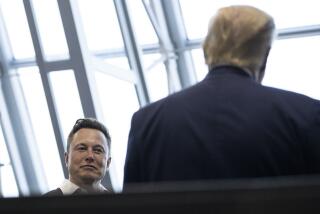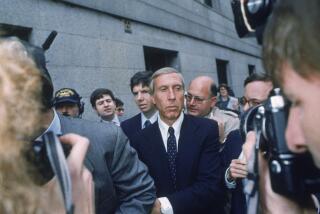Boesky’s Business Spurs New Controls
NEW YORK — The subpoenas fluttering around Wall Street in the wake of the Ivan Boesky scandal are almost as thick as the blizzard of ticker tape for the New York Mets’ World Series parade--and almost as many people are cheering on the sidelines.
Some of the loudest cheers come from regulators and would-be regulators who have been nervously watching the firecracker-growth of junk-bond takeovers that were reaching heights of ecstatic excess in the rush to close deals before the new tax law’s year-end deadline. If Drexel Burnham Lambert Inc., which has underwritten about half the $100-billion junk-bond takeover deals and has been the recipient of most of the post-Boesky subpoenas, turns out to have been a party to Boesky’s criminal activities, it will befoul the entire takeover industry, and the cry for regulation will swell.
Boesky’s business--politely called risk arbitrage--was betting other people’s money on takeover stocks. Trading on inside information is like fixing a horse race. Boesky could buy shares cheaply from investers who didn’t know their company’s price would shoot up after a takeover bid. Corporate raiders had an incentive to feed Boesky information to ensure that the target stock would be in friendly hands before a takeover vote.
But the sins of a Boesky do not justify the wholesale restrictions on takeovers that Sens. Howard M. Metzenbaum (D-Ohio) and William Proxmire (D-Wis.), and economist John Kenneth Galbraith, among others, are calling for. Galbraith thinks all hostile takeovers “should be stopped” or at least put on a one-year hold, on grounds that they are just “paper shuffling” transactions to benefit no one but speculators. Not surprisingly, executives of some of America’s largest companies--General Motors, Chrysler and Pfizer--are also in favor of restricting takeovers.
To decide whether or what kind of regulation should follow Boesky’s chiseling, it is important to understand why the junk-bond takeover market came to be. With all due respect to Galbraith, financial fads don’t spring to full-blown life because a junior investment banker wants a Porsche. Some underlying economic logic must be served or new ideas don’t fly.
The current corporate buy-out frenzy is the backwash of the conglomerate frenzy that swept Wall Street in the “go-go years” almost two decades ago. Corporate swashbucklers like James J. Ling and Charles G. Bluhdorn discovered the magic of debt financing. If a little tough company bought out a big weak company entirely for debt, the big company’s earnings would make the earnings per share of the little company’s stock shoot up. Since the stock market thought that rising earnings per share was a good thing, the little company’s price would soar, the swashbuckler would get rich.
Academics, always ready to support the latest fad with the latest theory, opined solemnly that diversified conglomerates were good for stockholders because they allowed managers to create a “balanced portfolio” of risk.
Go-go stopped when academics discovered that investors would balance their own portfolios of risk, thank you, and didn’t need conglomerate management to do it for them. More important, the market discovered that conglomerate swashbucklers often didn’t know much about managing the companies they were buying, particularly not big companies make weak by big debt. The stock market crashed, and stayed crashed for 15 years.
Everything on Wall Street is carried to wretched excess, and the stock market crash was no exception. The Dow Jones industrial average actually dropped slightly from 1968 to 1982, even though inflation halved the real value of a dollar’s worth of stock. When canny investors took a fresh look at the market a few years ago they saw two things: good companies with stocks that were grossly underpriced relative to their earnings and assets; and good divisions of big conglomerates that were buried beneath layers of white-collar bureaucracy.
On came the sudden onslaught of raiders, like T. Boone Pickens, aiming at sitting-duck targets, like Gulf Oil; Gulf stock carried a total price tag lower than the value of the oil it owned. Such raids put the fear of God--or worse, the fear of job loss--into corporate managers, and started the frenzied process of stripping away unrelated businesses, shrinking corporate staffs and buying back cheap stock to protect against outside attack.
Galbraith is correct when he claims there is yet no proof that corporate America is more efficient as a result. But it’s far too soon for such proof, and there is no doubt that big companies have been working hard to become less bloated. It is odd to find Galbraith, long the scourge of corporate gigantism, defending entrenched management.
Junk bonds came to be because there was more demand for loans to finance takeovers than the banks--having spent the previous decade tying up assets in Brazil and Mexico--were willing or able to lend. At the same time, federal regulations and the sudden stock market boom had created huge surpluses in corporate pension funds, while big institutional investors had become used to earning high interest rates during the 1979-82 credit crunch. Michael R. Milken, of the then-minor-league investment banking firm of Drexel Burnham, invented the junk bond to solve everyone’s problem, and Drexel rode the idea to the top of the investment-banking-league standings.
True to itself, Wall Street has carried the takeover rage to the point of wretched excess. Good deals are now harder and harder to find because the stock market has corrected its underpricing. If anything, companies are now on the expensive side. But the big fees that can be earned from a takeover and the sheer excitement a hostile tender generates, has spawned legions of acquisition-eyed yuppies, chasing a fee and a new boat.
Even the existence of businesses like Boesky’s--or like that of Boyd Jefferies, another subpoena recipient who runs round-the-clock trading operations so raiders can move big blocks of stock faster--is a sure sign that a once-healthy trend is running its course.
The proper regulatory response, however, should not be to curb the issuance of junk bonds or to stop takeovers. Junk bonds are not peddled to the man in the street. The $100 billion issued so far is still only a small slice of the trillions in investment assets controlled by the big buyers--pension funds and insurance companies. And the performance of most junk bonds, so far at least, has been excellent, despite a few well-publicized failures like People’s Express.
The dangerous trend of the past year or so has been that the big investment houses are so hungry for takeover fees that they bet their own capital to win deals. Merrill Lynch backed Sir James Goldsmith’s recent bid for Goodyear with almost $2 billion, or more than half of its total capital, and far more than any bank would have been allowed to lend. Merrill Lynch is not big enough to take that kind of risk--although its mergers and acquisition staff is aggressive enough--but it is big enough to cause financial havoc if a deal goes sour. Sensible capital constraints, like those that apply to the banks, however, would seem to be the only regulation that is called for.
The best government response to the Boesky affair would be stiff prison sentences for Boesky and any implicated colleagues. Tighter regulation on investment bank capital commitments seems clearly called for as well--quite apart from the Boesky scandal. For the rest, government regulation should wait until there is much better evidence that the system needs it.
More to Read
Inside the business of entertainment
The Wide Shot brings you news, analysis and insights on everything from streaming wars to production — and what it all means for the future.
You may occasionally receive promotional content from the Los Angeles Times.










